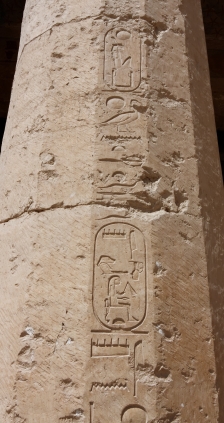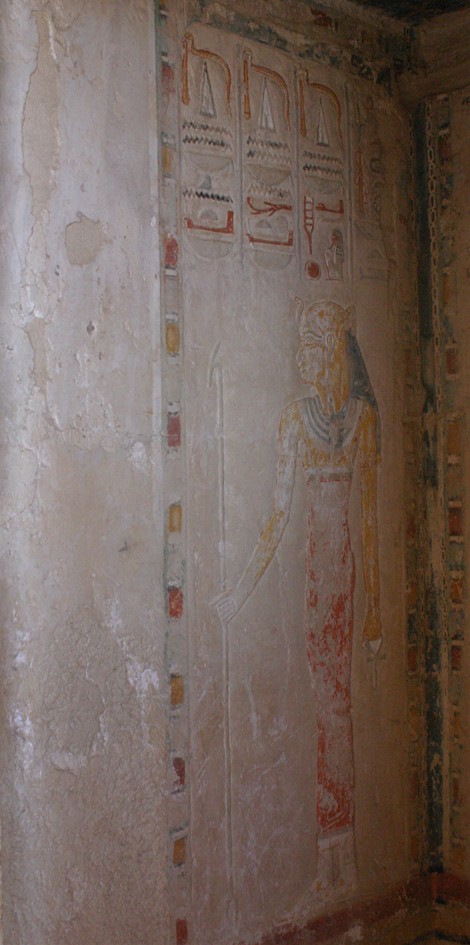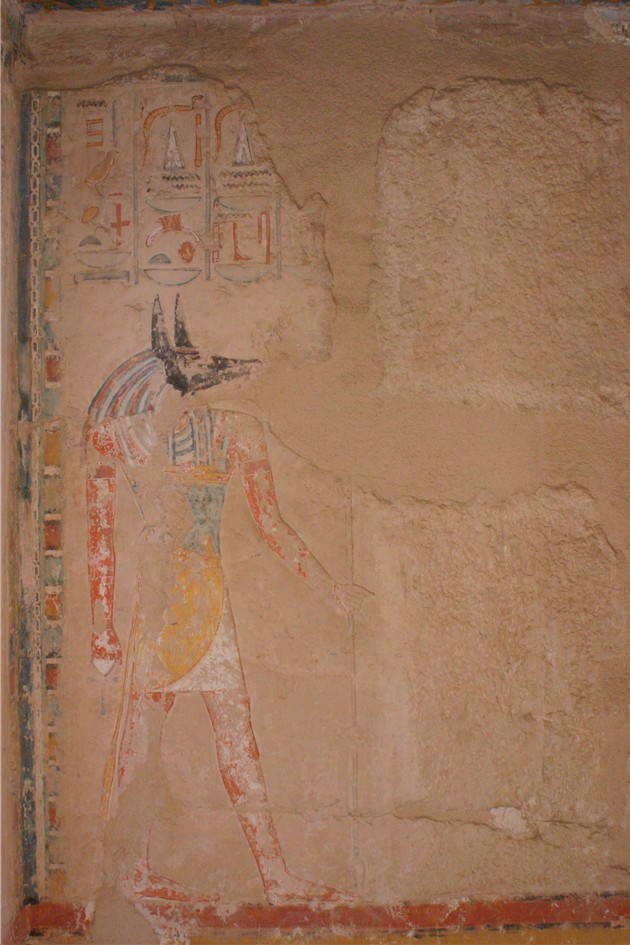|
The Lower Chapel of Anubis on the Middle Terrace of the Temple
Djeser djeseru |
update:
14.03.2011
|
| The following pictures show the floor plan of the Lower
Chapel of Anubis and some photos taken in the hypostyle of the chapel. The three
rooms of the chapel are not open to the public, only the first room (the
Vestibule) can be
looked at through the grating of the door. |
|
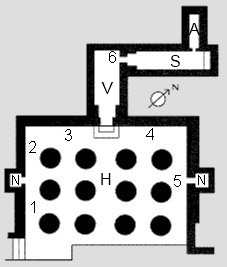 |
|
Ground plan of the Lower Chapel of Anubis;
the numbers locate the following scenes:
|
|
1. Anubis leading Hatshepsut (erased) into the chapel |
|
2. Hatshepsut (erased) between Nekhbet and Ra-Horakhti, |
|
3. Hatshepsut (erased) offering to Amun |
|
4. Hatshepsut (erased) offering to Anubis |
|
5. Thutmosis III offering to Sokaris
|
|
6. jmj-wt-fetish (Vestibule) |
|
N = Niches
|
| Witkowski (1989) identified the following structural elements
H = Hypostyle Hall, V = Vestibule
(1st room), and
S = Sanctuary (2nd room), A = Annex
(3rd room) and made the point that the Lower Chapel of Anubis
- in contrast to the Upper Chapel of Anubis -
contained all
functional elements of an independent temple. Furthermore, he noted that the
decoration in the sanctuary (and annex) is nearly identical with the decoration of the
corresponding two rooms of the Upper Chapel of Anubis.
|
| The decoration of the two Chapels of Anubis shows at first
sight that they were above all the place where the king practiced the
divine cult. Thus, the representations in the hypostyle hall of the Lower Chapel
show the beginning of the royal actions: his arriving at and his entering of the
temple. |
| The hypostyle hall is well preserved.
Internally the measurements revealed that the hall is about 11.1 ms wide, about
6.6 ms deep, and about 5.6 ms high (Naville, Part II, 1896). The stone ceiling resting on massive architraves, and the
twelve 16-sided columns supporting
the latter being all intact. The spacing between the columns is wider in the center to allow
a better approach to the chapel. The ceiling is painted blue strewn with yellow stars. |
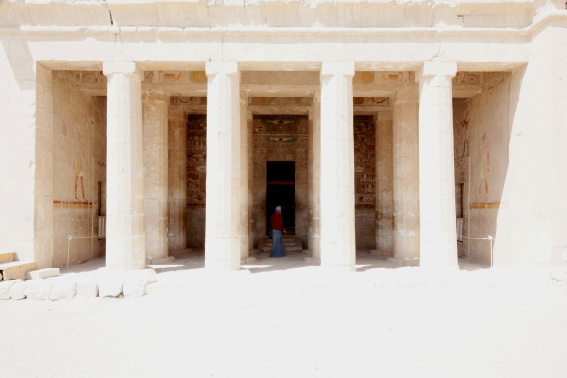
| All columns show remains of a vertical
inscription on the middle outer surface. However, only on the left column the
inscription two cartouches of Hatshepsut have survived (Photo left by E. Noppes). |
| The floor consists mostly of solid rock. The floor is about 75 cms below
that of the 2nd portico and only a few centimeters higher than the middle platform. |
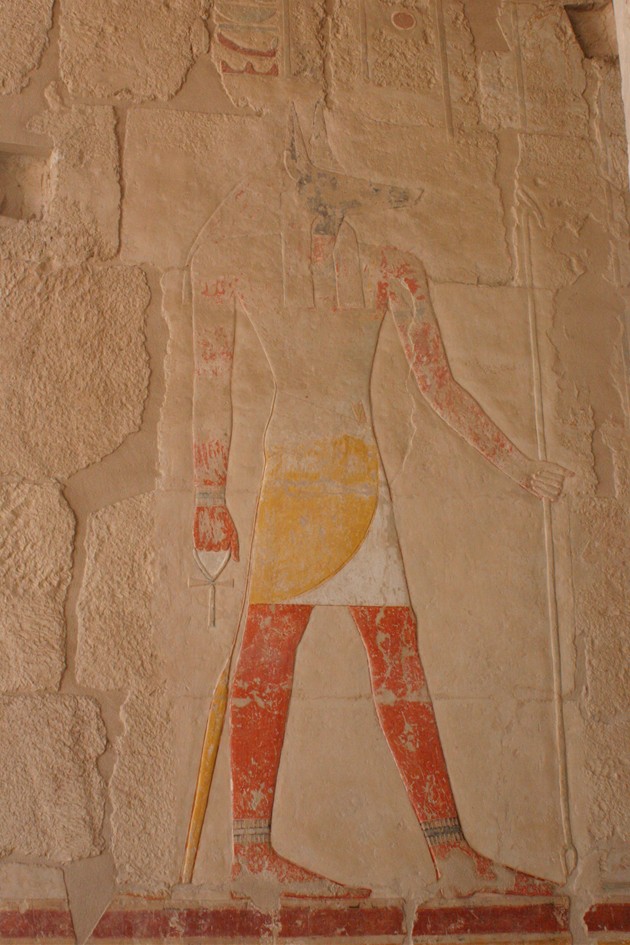
| The scene above shows the queen (erased)
introduced into the chapel by Anubis (pos. 1 in the floor plan). Most of the
accompanying text has been destroyed. However, Naville still red: "The going in
and out, the introduction of the king into the sacred shrine of Anubis, who is
on his mountain, who resides in Djeseru." |
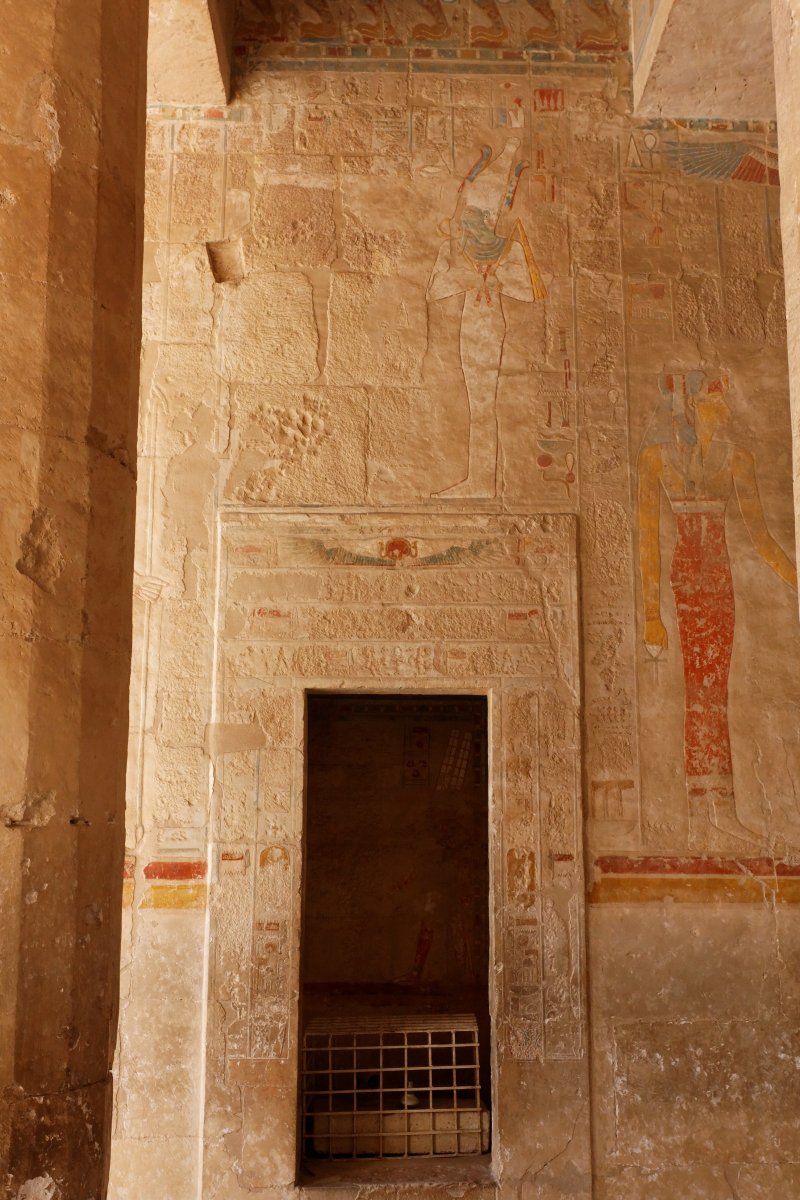
| The photo above shows the scene of the the southern niche,
where Hatshepsut is shown libating before Osiris-Chontamenti (center of the southern wall,
between pos. 1 and 2). The text above Osiris reads: "Wsjr-#ntj-jmntj
nTr aA nb pt = Osiris-Chontamenti, Great God, Lord
of Heaven." |
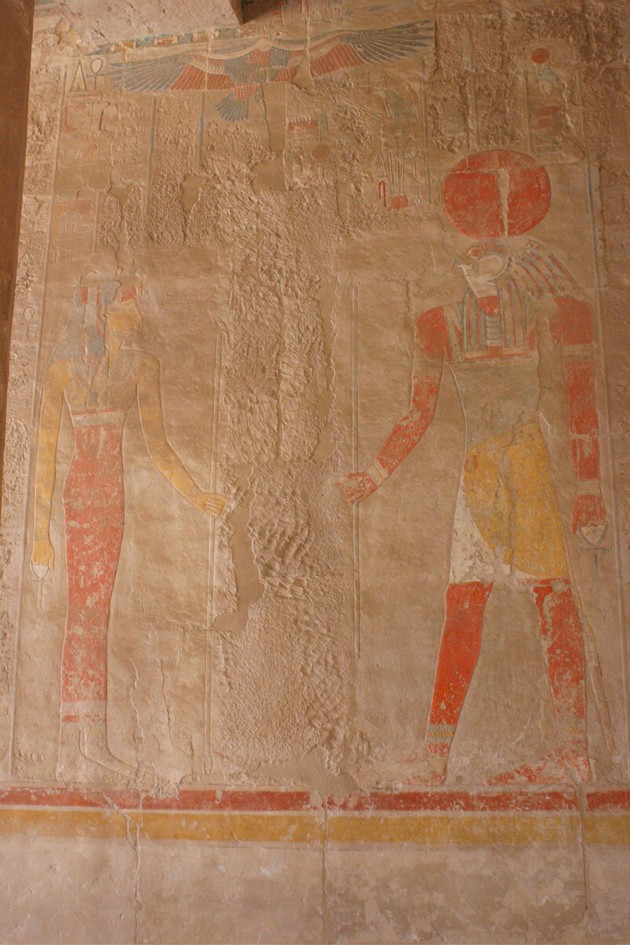
| The scene shows the queen (erased) between Nekhbet
and Ra-Horakhti (pos. 2). |
| The following scene on the west-wall of the Hypostyle Hall
showed the queen on the southern side (left) of the entrance to the vestibule
with the White Crown of Upper-Egypt and on the northern side (right) with the
Red Crown of Lower-Egypt (Naville, Part II, 1896). |
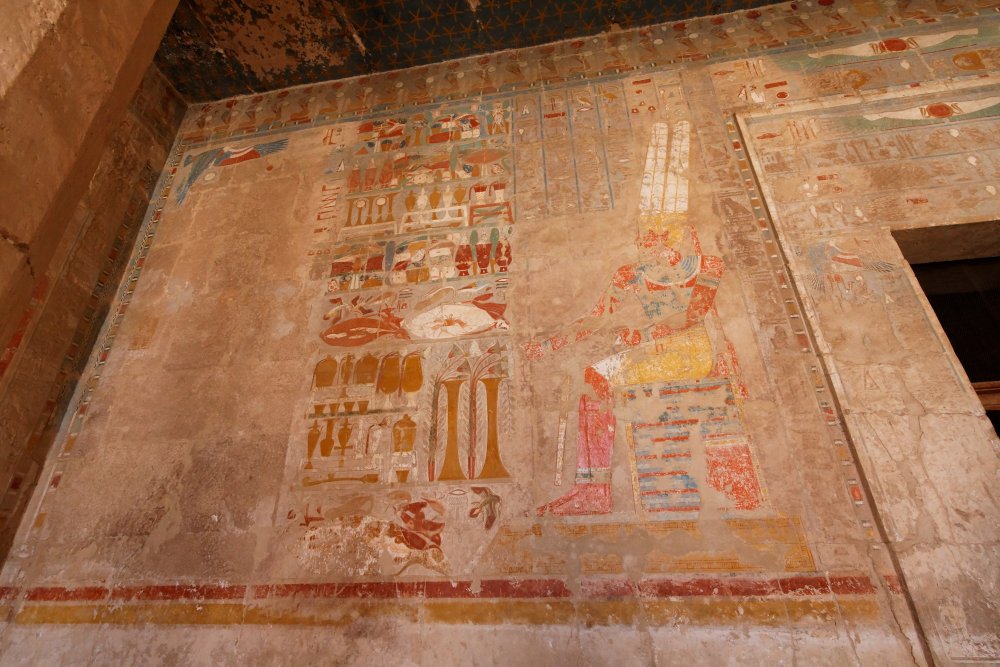
| Amun seated in front of a table with offerings,
the figure of Hatshepsut, depicted left of the table, had been
erased (pos. 3) |
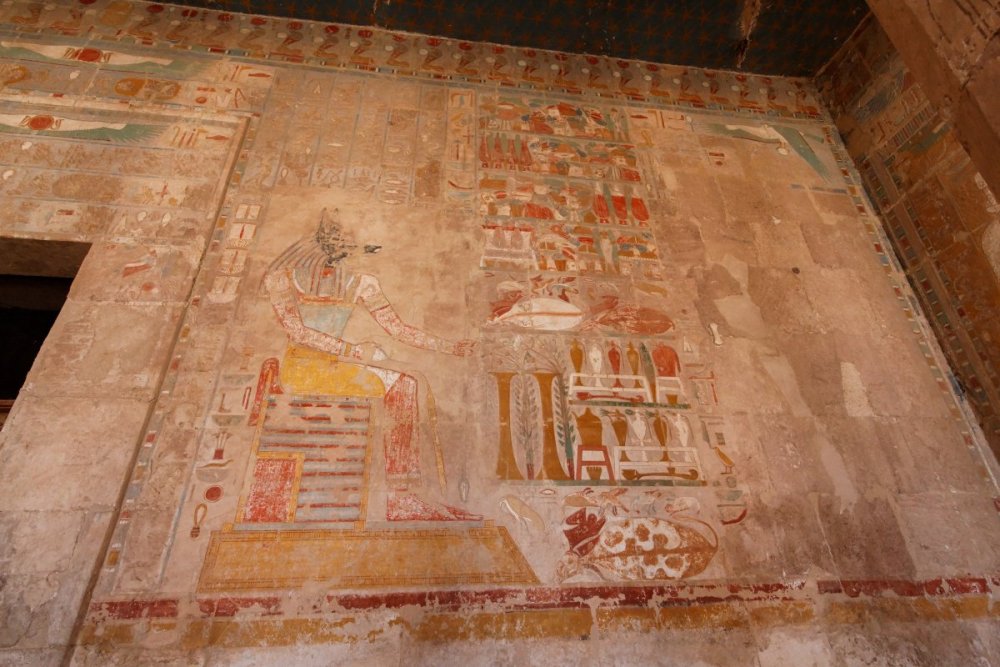
| The next photo taken in the portico shows Anubis enthroned in front of a
table with offerings. The figure of Hatshepsut who was depicted right
of the pile of offerings had been erased (pos. 4) |

| The photo above taken from the western part of the
north-wall of the portico shows the jmj-wt-fetish inside a shrine. The figure of
Hatshepsut sanding in front the fetish had been erased (left of pos. 5). |
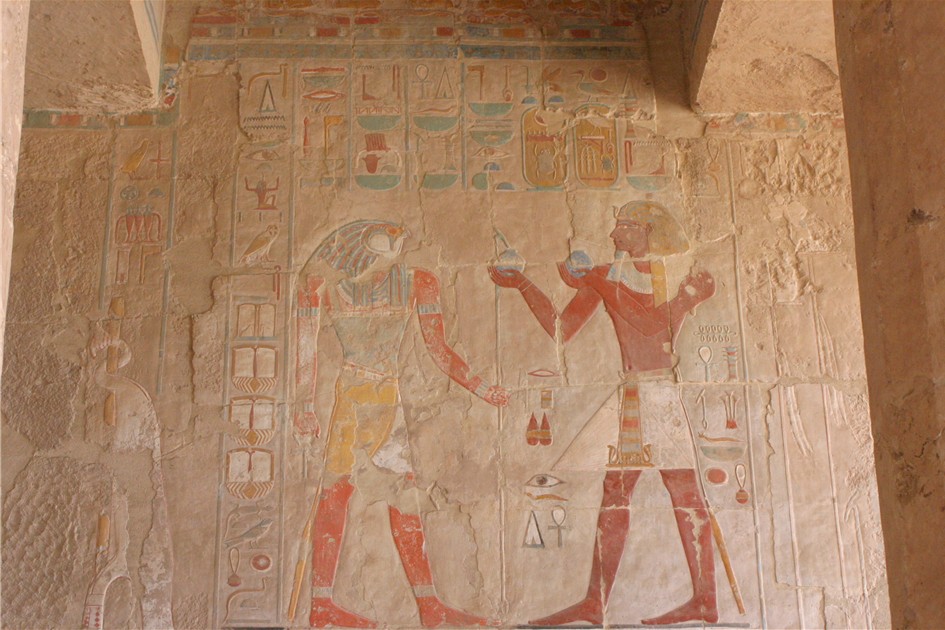
| Thutmosis III offering wine to Sokarj, The Great
God, Lord of Heaven,
(pos. 5, above the northern niche) |
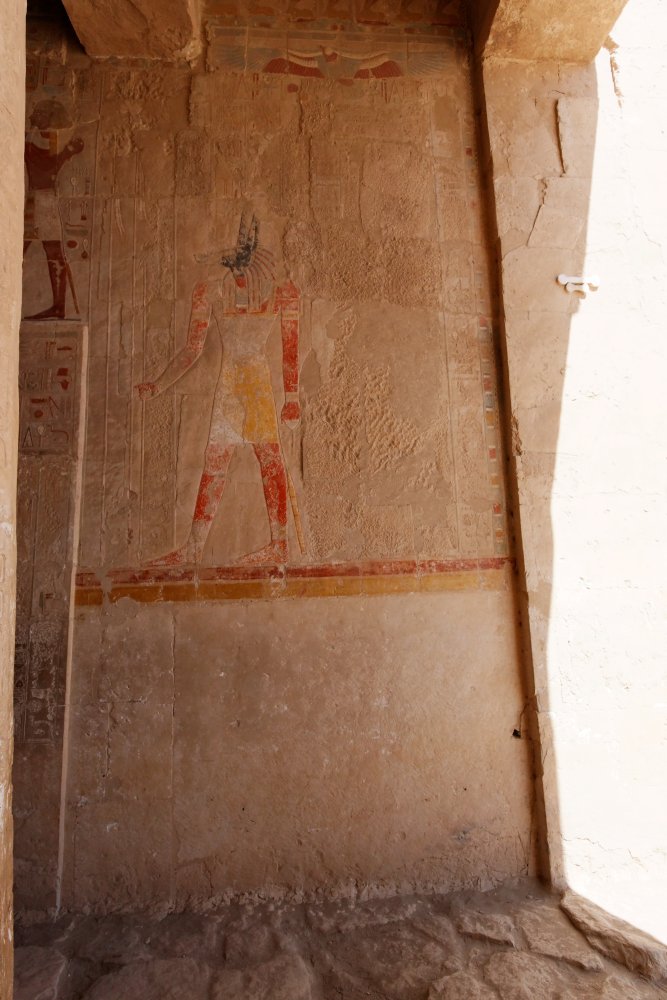
| On the eastern side of the north-wall the last scene of the hypostyle
shows again Anubis leading the queen (erased) into the sanctuary.
|
| The Niches of the Hypostyle Hall
|
| The southern niche was dedicated to Amun, the northern one to Anubis.
The frames around the niches contained nothing but names and titles of the
queen, mostly erased. |
 |
| The rear wall of the southern niche showed
Hatshepsut (erased) before Amun. On the side walls Mut and Buto were
depicted. |
| The rear wall of the northern niche showed Hatshepsut
(erased) before Anubis. On the side walls Nekhbet and Buto were depicted.
|
| A few steps are leading to the entrance of the vestibule
(see photo below) and the two chambers.
|
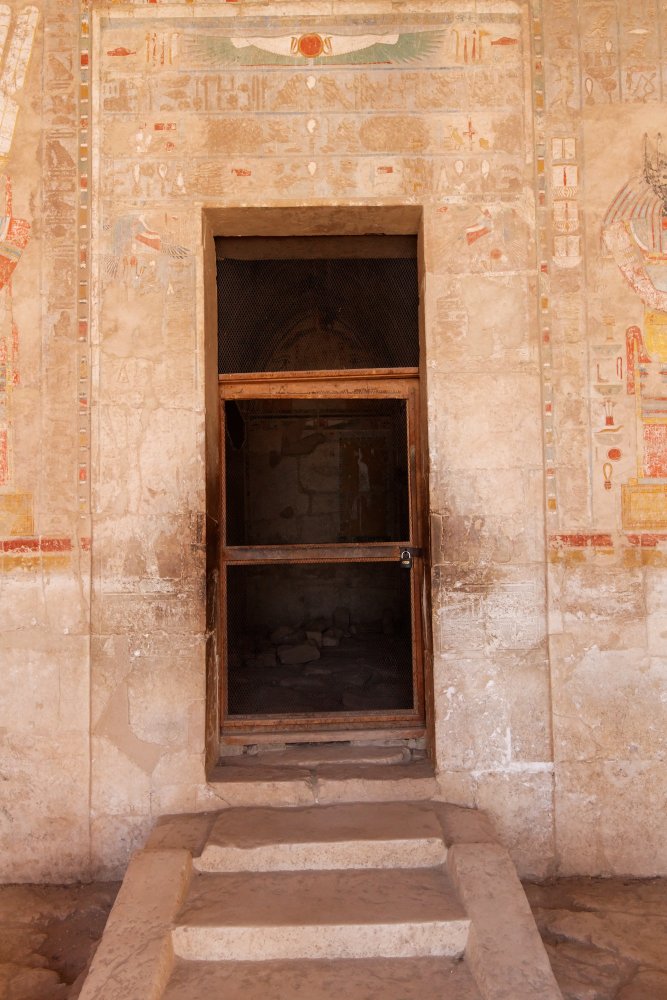
| The following two horizontal lines right (see photo below) and left of the
doorway contain - covered by a "pt"-sign - the name of the doorway "The door
[named] Hatshepsut (changed to Thutmosis
II), with lasting DfAw-food in the house of Anubis [= sbA
aA-xpr-n-Ra mnt
DfAw
m pr Inpw]" (Grallert, 2001).
|
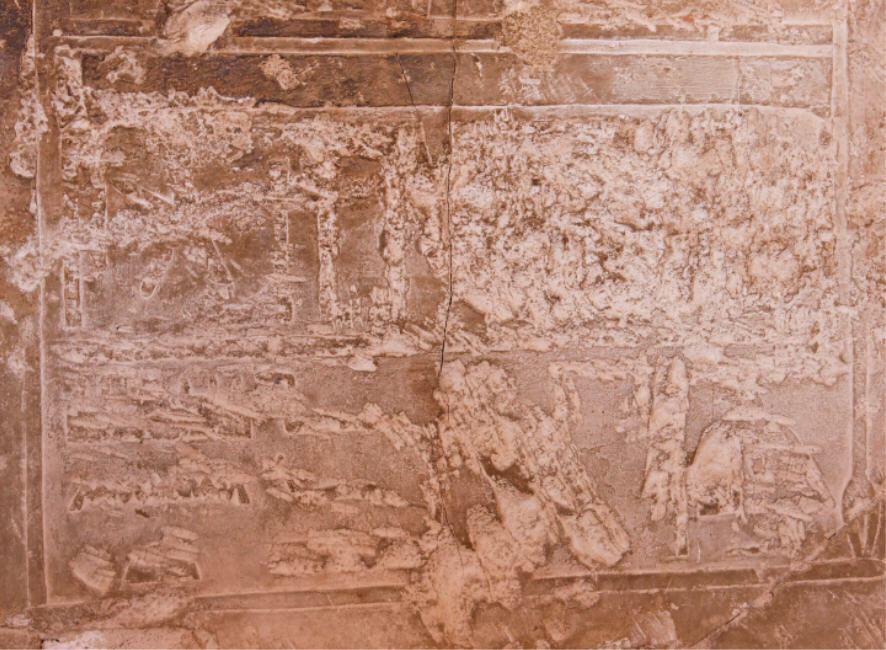
|
The rooms of the chapel shows a typical arrangement. The rooms were not
built in a row but every successive room was positioned in a right angle
to the preceding room. This blocked the view into the depth of the chapel
and emphasized the secret nature of the ceremonies performed there.
|
|
Anubis was an important god participating in the transformation of the
deceased on his way to the afterworld. Anubis was responsible not only
for the deceased to overcome the trauma of death but also for the
deceased king to become a powerful god. Only then the deceased king
could have taken over his part in the cosmic cycle of the daily journey
of the sun god.
|
|
Apart from Anubis the scenes also depict
other deities (e.g. Osiris and Sokar) and symbols (jmj-wt-fetishes) which played an
important role in overcoming the trauma of death.
|
|
The scenes on the side-walls of the vestibule (see photo above from Werbrouck,
1949) show repeatedly Hatshepsut (figures destroyed) officiating before Amun.
The rear wall shows the queen (figure destroyed) before the jmj-wt-fetish
which is mounted in a shrine (see photo below). |
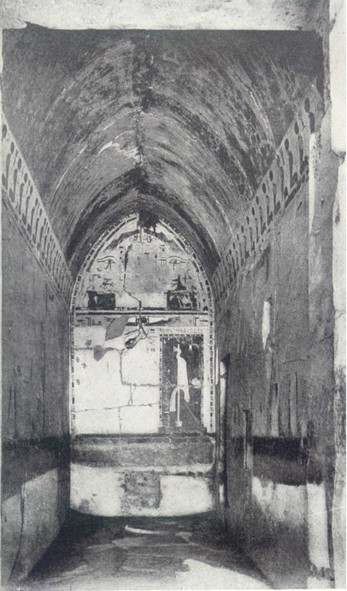
| The photo above (taken from Werbrouck, 1949) shows the vestibule. Near to the rear wall opens in the right wall the entrance to the sanctuary. |
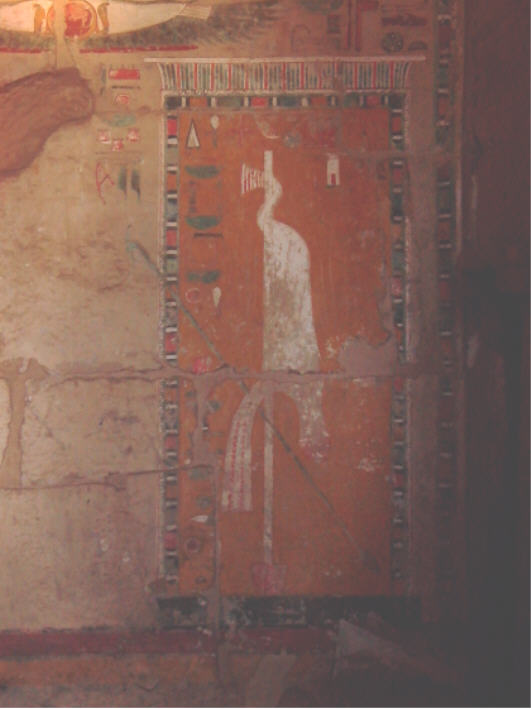
|
The photo shows the jmj-wt-fetish
mounted in a shrine depicted on the west-wall of the vestibule. |
| The scene on the north wall of the sanctuary shows Hatshepsut
(erased) standing between Anubis (left) und Hathor , "Lady of the Mountain" (right),
who both promise to the queen protection and a long life. |

| The photo above shows the sanctuary of the Lower Chapel (photo
taken from Werbrouck, 1949). |
|
The east-wall (right) of the sanctuary shows several offering scenes before
different divinities: first Anubis appears twice to whom Hatshepsut probably
offered grains of incense, behind these scenes Osiris receives four red vases of
water from Hatshepsut. The following scene shows Thutmosis III officiating
before Sokar, " Lord of the cave", presenting him four offers four vases. The
last scene shows again the queen who opens the shutters of the shrine of Ptah
and draws away the veil from the face of the god. |
| Naville (1896) gives no detailed description about the
decoration of the west-wall of the Lower Chapel of Anubis . After Witkowski
(1989) the sanctuaries of the Upper and the Lower Chapel of Anubis were nearly
identically decorated. Therefore, the west wall should show at least 3 scenes in
which Hatshepsut presents gifts to Anubis (2 times) and to Amun. However, the
photo by Werbrouck (see above) shows three scenes in which Anubis is shown
receiving the gifts. |
| A bench extended over the entire lower range of the
north wall which probably had been used to put up gifts for
the gods. |
| After a few meters the entrance to a small room (Annex) opens
in the western wall of the sanctuary. |
| About the decoration of the annex Naville gives no information. |
| However, the photo taken from Werbrouck (below) shows that the scene on
the west-wall (rear wall) presents Hatshepsut (figure destroyed) standing before
Anubis. |
| The tympanum shows the cartouche of Hatshepsut in the center,
framed on both sides by "Dj anx-f". The cartouche is protected by
a winged sun-disk with two pending uraeus (= BHdtj). Again the whole
scene is covered by the sign of the heaven which is decorated with stars. The
heaven-sign is carried on both sides by a "wAs"-sign. The whole
scene is enclosed by a colored band and a chain of cartouches. |
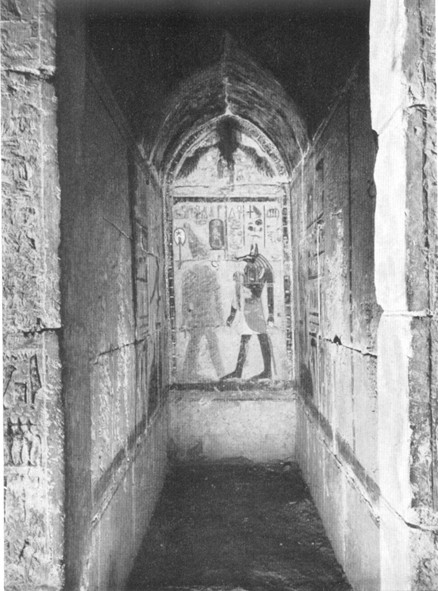
| The scene on the west-wall of the last room (see photo above from Werbrouck, 1949) show Hatshepsut
before Anubis.
|
| The photo from Werbrouck gives no information about the
decoration of the side-walls. |
|


